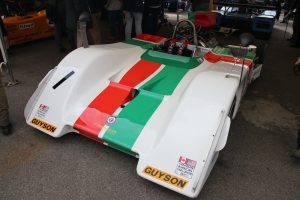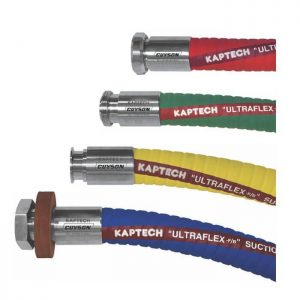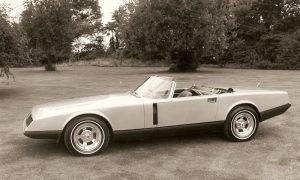SANDBLASTERS, E-TYPES AND MORE … STEVE HOLE TELLS THE MOTORSPORT STORY OF GUYSON INTERNATIONAL

I guess the majority of totalkitcar.com and Classic Kit Cars & Specials readers may have heard of the Guyson E12, the work of the legendary, late William Towns. However, although the Jaguar E-type-based E12 was the only recorded collaboration between Towns and Guyson, the Leeds-based company did other cars, albeit race-inspired ones.
The company, Guyson International still exists and produces a variety of machinery focusing on industrial blasting and indeed, if you work in that field that may well be very well-known to you.
Founded as Guyson Industrial Equipment Ltd by Robert Thompson in 1938. The origins of the Guyson name? Quite simple. Robert’s uncle, Guyatt Thompson provided the finance, so we have a conflation of GUYatt and ThomSON. Simple as that.
By 1939, they had begun marketing American-made Hansen Quick Release Couplings (a relationship that still exists to this day) in the UK. Robert’s son, James joined the firm in 1953 and opened up the world to Guyson, making them a truly international company. He developed the US and European networks.

So, if you want a blast machine, be it manual or automated, or an ultrasonic cleaner (we’re not talking home hobbyist here) the Skipton-based Guyson (they moved to their new HQ in 1980) is a company you should be talking to.
Quite aside from the Guyson E12, the Thomsons have always been interested in motorsport and have always been keen and longtime supporters of the UK’s hillclimbing scene. James Thompson’s son, also James is a great saloon car driver and was British Touring Car Champion in 2002 and 2004 and European Touring Car Champion in 2009 and 2010.
Well-known hillclimb driver, the late David Hepworth (of classic car restorers and race preparation company Hepworth International) won the Shell RAC British Hillclimb Championship in 1969 and 1971 in a car he’d built himself and supported by the Thompson’s called the Guyson Sandblaster Special, which made its first appearance in 1968 at Oliver’s Mount Hillclimb in Scarborough.
In 1969, Hepworth (well worth Googling him) also entered the car in the inaugural season of the British F5000 Championship with drivers such as Bev Bond and Tony Lanfranchi driving it. In 1970 and 1972, Hepworth missed out narrowly taking the Championship just losing out to Sir Nick Williamson on both occasions.
That car was very quick especially when a 500bhp Chevy V8 was transplanted in place of the original Traco-built Oldsmobile V8) and it naturally evolved over the years and remained competitive into the seventies. Hepworth, I think, took 18 hillclimb victories in the car.
Let’s quickly talk about the E12. Guyson’s then-boss James ‘Jim’ Thompson who wanted more performance from his V12-powered E-type and when he crashed it into a tree one day in 1972, he commissioned William Towns to not only rebuild it but to come up with a body conversion for it.

Firstly though, he addressed the performance issue by sending the engine to top Jaguar XK tuner and builder Ron Beatty, then of Kenilworth Racing Services who tweaked it and added a bank of six Weber LDF carbs resulting in a power hike to 345bhp (up from 251bhp).
Beatty always said that he could have gone further with the addition of a forged bottom end and spikier cams. He reckoned that 400bhp plus was perfectly feasible. Even so, it was by now a really quick car that could hit 60mph in less than five seconds, although the penalty was a 10mpg fuel habit!
Meanwhile, Thompson’s friend William Towns came up with a clever set of GRP panels that were screwed to the Jaguar’s structure (after the rebuild the Primrose Yellow E-type was red and wore the numberplate ‘GUY 50N’) meaning that the E12 could be turned back into an E-type at a later date.

When it was decided to commercially offer conversion packages of the E12 customers could leave the engine as standard if they so wished. For example, if they went for the Weber package (at £454) a power bulge was needed in the bonnet for clearance reasons.
Towns owned the second E12 built, although he left his engine standard as he didn’t like the look of the bonnet bulge. Other options were available such as a stainless steel exhaust upgrade priced at £86!
In 1974, an E-type S3 V12 cost from £3300. The Guyson conversion package added £2277 inc VAT to that base price, which is possibly what hindered sales.
The Guyson E12 was officially unveiled to the public on October 16 at the British Motor Show at Earls Court, London. Towns had, incidentally beefed up the suspension and added Koni dampers all-round. The result was that it was 46kg heavier than the ‘donor’.
One of the two E12s was definitely returned to an E-type in later years.
If you want to find out more about Guyson International’s current activities visit www.guyson.co.uk
Incidentally, current managing director, James (ex-BTCC driver) Thompson’s son, Jimmy has motorsport in his veins (understandably enough) and has competed in the Ginetta G40 Cup.










